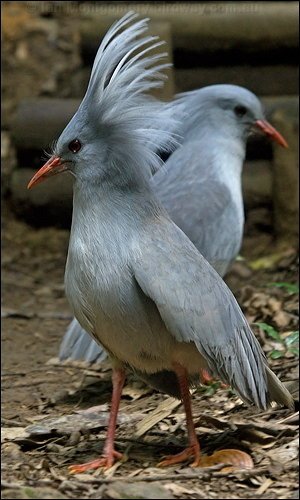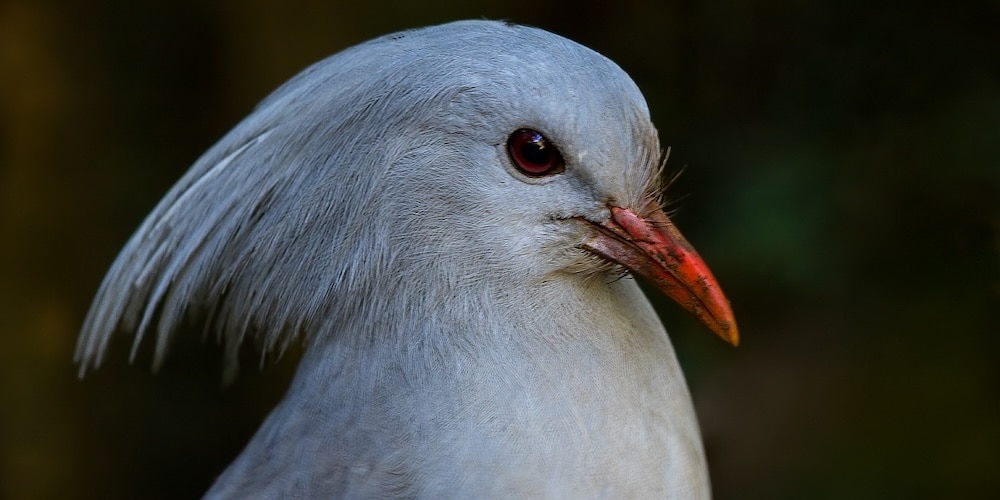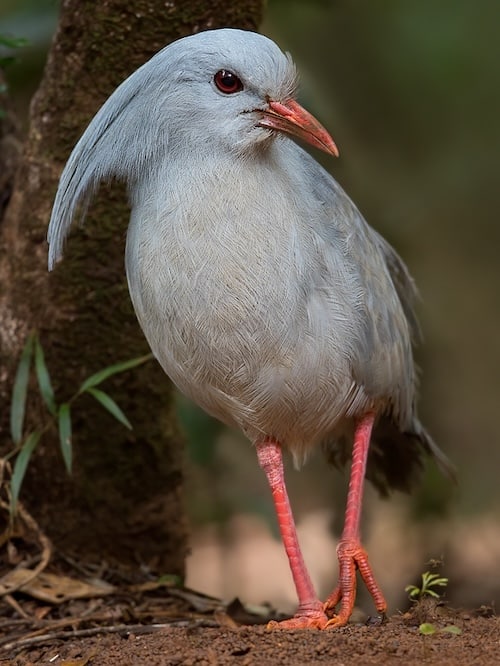Rhynochetidae – Kagu

Kagus aren’t just great birds in their own right, they are also of great taxonomic and bio-geographical interest. The Kagu is the single member of its family, the Rhynochetidae. It’s only rather distant living relative appears to be the Sun Bittern of South America, which is also the member of a single-species family the Eurypigidae. These two families used to be included in a heterogenous collection of birds in the Crane order (Gruiformes), but recent DNA studies (Hackett et al 2008) have led to their elevation to their own two-species order the Eurypigiformes. This makes them very distinguished – the other 39 or so orders of birds contain about 10,000 species.
The traditional bio-geographical explanation for this is that both species had a Gondwana ancestor that existed on New Caledonia when it separated from Gondwana 80Mya (million years ago). Recent studies (see Grandcolas et al 2008) indicate that New Caledonia has probably been completely submerged since then and all terrestrial plants and animals have colonised it in the past 37 million years. If this is correct, then either the simple Sun Bittern – Kagu relationship is incorrect or their ancestors found some other way to get to where they are now, such as island hopping with extinctions obliterating their tracks. The mystery remains…

Kagu Rhynochetos jubatusb – ©Dubi Shapiro
It is an endemic, which is native to New Caledonia. The one pictured top left was photographed (June 2015) in Rivière Bleue National Park – 90 minute drive from the capital Noumea.
They are around 50-55cm (20-22in) long and adults have long crests that usually droop down their backs or over their wings, unless, as above, it is displaying. Virtually identical females have fine barring on the upper wing, although juveniles also have this barring. They are flightless but still have relatively long wings which they use for balance when rushing around as well as when displaying. They make a sort of throaty hiss.
They probe soft earth for earthworms which make up much of their diet although they also eat other invertebrates including millipedes that other birds find too noxious. They also eat small vertebrates such as lizards and mice, especially when the ground is harder to probe.

Kagu Rhynochetos jubatusb – ©Dubi Shapiro
Kagus form strong pair bonds that can last for years and vigorously defend territories of about 20 hectares or 50 acres in extent. They lay a single large egg in a rough nest on the ground and the young birds can stay in the parental territory for a year or two. Both adults share incubation and feeding of the young bird.
Kagus are rated as endangered, though recent conservation efforts have improved the situation. They suffer from predation by dogs, pigs and rats – Captain Cook started the rot (1774) when he introduced dog to New Caledonia. They’ve also suffered from logging of rainforest and fragmentation of their habitat by clearing. The population reached a low of perhaps 600-700 birds (1991) but has increased since and is thought to be about 1500 now as a result of predator control and captive breeding and reintroduction. Conservation is helped by its iconic status and it is widely used as symbol of New Caledonia. Such as on the 1000 French Pacific Franc note, which of course is called the Kagu.
-
Number of bird species: 1
(As at August 2025)
The Kagu is the single member of its family, the Rhynochetidae, one of two single species families of the Eurypigiformes order. It is:
Kagu Rhynochetos jubatus
-
Birds of Melanesia - Bismarcks, Solomons, Vanuatu and New Caledonia
| By Guy Dutson | Helm | 2011 | Paperback | 447 pages, 75 colour plates, colour photos, colour maps, b/w illustrations, tables | ISBN: 9780713665406 Buy this book from NHBS.com
-
Rhynochetidae
Family AccountRhynochetos is a genus of ground-dwelling[1] birds in the monotypic family Rhynochetidae. It contains two species, both endemic to New Caledonia, one of which is extinct.
-
Kagu Rhynochetos jubatus
Species AccountThis unique and charismatic large flightless bird is the flagship species of New Caledonia. -
Kagu Rhynochetos jubatus
Species AccountThe kagu or cagou (Rhynochetos jubatus) is a crested, long-legged, and bluish-grey bird endemic to the dense mountain forests of New Caledonia. It is the only surviving member of the genus Rhynochetos and the family Rhynochetidae, although a second species has been described from the fossil record. -
Kagu Rhynochetos jubatus
Species AccountKagu Rhynochetos jubatus has most recently been assessed for The IUCN Red List of Threatened Species in 2019. Rhynochetos jubatus is listed as Endangered under criteria A3e+4ad; C2a(i). -
Kagu Rhynochetos jubatus
Species AccountSound archive and distribution map
-
Ian Montgomery
Bluewater, Queensland, Australia | ian@birdway.com.au
Birdway
